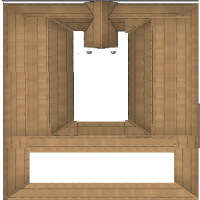Title: The Moldy Unicorn
Code: N/A
Author: Nate Treme
Rule Set: Angostic
Year: 2019
Pages: 6
Number of characters: As needed
Levels: N/A
Rating:
★★★★★
If a book has a good cover, I'll probably take a look. If it has that haute 70's look, the smash of day old banana and lime colored paste, I'll do a double take. If it has both of the above, plus the childish, rounded look of a composition notebook, my brain shuts down and the money comes out, no questions asked.
Well, that's what happened with The Moldy Unicorn a few days ago. I purchased one of a few physical copies based on a single image on MeWe.com. And then I forgot about it.
It arrived today.
I opened the envelope and was all disappointed. It was tiny. Really tiny. "I paid money for this?"
Then I opened the booklet. And the frisson hit. Suddenly, I was 8 year old me, standing in Walden Books, smelling nasty carpet chemicals and mall pretzels, looking a copy of the Red Basic D&D rule book. Gary, Dave and Tom whispered, "Go ahead, turn the page."
The thing is six g-ddamn pages, packed with amazing stuff. Pages 1 and 2 describe The Moldy Unicorn with a colorful map. Page 3 lists encounters for the Inn. The next page describes how to design a Demon, with 3 tables, conveniently labeled 1-12 for easy die rolling. The last two pages are a mini dungeon, Grotburk Crypt.
The artwork is excellent. It isn't excellent in the sense of a masterpiece, but the odd, brightly colored outsider art that masters cannot duplicate. The text is tight, it has to be in a volume this small.
While its only 6 pages (8 if you count the covers, the thing that made me **WANT** this 'zine), those pages are highly concentrated. Being so tiny, it is delicate. I already know that I am going to buy a special picture frame for this. I am just moments away from heading to DriveThruRPG and purchasing an electronic copy, to jealously protect the physical copy like mage protects his spell book.
It's been decades since I have been this happy with a purchase. Of course, I've read it cover to cover. But I'm going to do it again tomorrow. And the next day. This is great buy. This is well worth the
$6.00 for the physical copy (Sold out, sorry),
$10.00 for the PDF.
To put some perspective on the Star Rating above, I review a lot of things. Computer hardware and software, novels, games, historical books, etc. If I'm not going to give something 3 stars, I'm not giving any stars. If you're not going to give at least 3 stars, its like trash talking people. This is the first time I have been compelled to give 5
gold stars, underlined. I've reviewed several of my mom and dad's books. I don't hand out gold stars. It is very rare that I am so enchanted with any product to completely rethink my rating system.
![City of Nexus | 20x30 Battlemaps [BUNDLE] City of Nexus | 20x30 Battlemaps [BUNDLE]](https://www.drivethrurpg.com/images/12792/297531-thumb140.jpg)










































